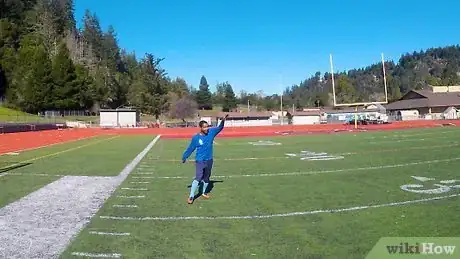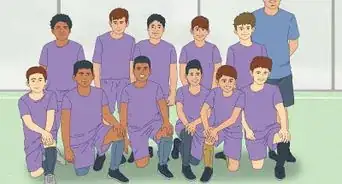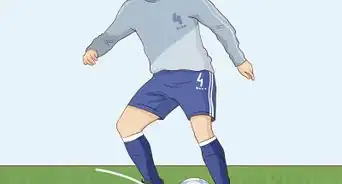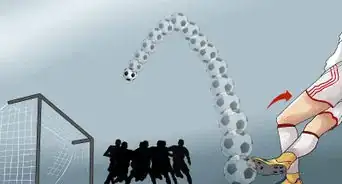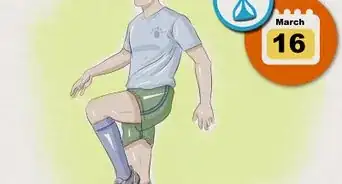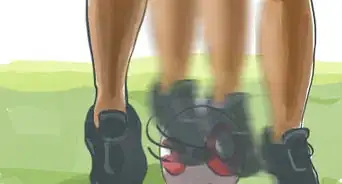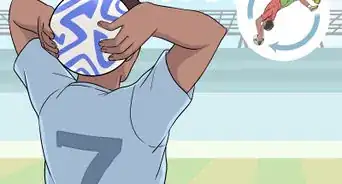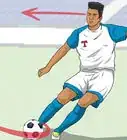This article was co-authored by Walter Merino. Walter Merino is a Youth Soccer Coach and Co-Founder of Ole Soccer Club based out of the Los Angeles, California area. He has coached youth from the age of four to the high school and college levels. Walter has played collegiate soccer for Cal Poly Pomona and Los Angeles Mission College. His accomplishments include coaching Olé Soccer Club to win the 2017 Cal South State Cup Governors Boys 2007 Division title.
There are 9 references cited in this article, which can be found at the bottom of the page.
wikiHow marks an article as reader-approved once it receives enough positive feedback. In this case, 90% of readers who voted found the article helpful, earning it our reader-approved status.
This article has been viewed 115,195 times.
Back to the goal, out of position, well-defended, you receive a perfect crossing pass. Hope is not lost. From Pele to Wayne Rooney, many of the greats have stymied goalies with a well-timed bicycle kick that redirects a brilliant pass to a bad position, making a great shot in the process. You can learn the basics of completing a bicycle kick yourself, as well as how to practice properly and look for the right opportunity in a game.
Steps
Learning the Basics
-
1Turn your back where you want the ball to go. To do a bicycle kick properly, you'll basically need to fall backward and kick the ball up and over your head, in the opposite direction from where you were facing. It's an unexpected and spectacular play when done properly, because you're facing the other direction.
- Most bicycle kicks are done inside the penalty box, upon receiving some kind of cross or other pass, in an attempt to score. It's usually not something most players intend to do, but something that you might end up having to do in the moment.[1]
-
2Push off with your kicking foot. To start the motion of the classic bicycle kick, lift the knee of your non-dominant foot and push off the ground with your kicking foot. The higher you can lift your non-kicking foot the better, because this will help you get the momentum necessary to get your kicking foot up and over properly.[2]
- Depending on where you are on the field and how close you are to the ball, you may want to kick with one or the other feet, but you want to push off with the same foot you want to kick with.
Advertisement -
3Dip your head and shoulders backwards. As you raise your leg, throw your momentum backward, as if you’re trying to get away from the ball and flop back down on the ground. Be careful not to throw your head back too quickly, or to dip your body into a full-on flip. Stay focused on the kick and making contact with the ball, not falling back super-fast.[3]
- Think of the scene in The Matrix, in which Neo's trying to get out of the way of a flurry of bullets by bending backward. That's what you're going for, but faster.
-
4Lift your kicking leg straight up as you fall. As your momentum carries you backward, “bicycle” your legs, bringing your non-kicking foot back down toward the ground, and bringing your kicking leg, which you jumped off, up toward the ball to make contact.
- This rotation of the feet is where the kick gets its name, using your non-kicking leg to propel you and give you leverage to kick the ball backward.
-
5Strike the ball.[4] Use the ridge on the hardest part of the top of your foot, if possible, driving the ball straight over your head and back behind you. Ideally, you want to kick the ball flush on the opposite side of the ball from the goal, and not on the bottom of the ball, which might end up sending the ball straight up in the air.[5]
- It’s very difficult to make contact with a ball clean during a bicycle kick, which is why it's more commonly used as an improvised maneuver at the last minute. Keep your eye on it closely and try to get the best touch on it you can.
-
6Brace yourself. Put your arms out to your sides to brace your fall and catch yourself with your arms as wide as possible to take the bump pressure off your back and your hips. Be very careful not to rotate backward too quickly,
- Some players prefer taking the bump with the side, rather than flat-backing. Practice some bicycle kicks and get a feel for what works best for you and your style of play.
Practicing Safely
-
1Only practice on grass. Obviously, falling onto your back to do a kick isn't without its hazards. To decrease the possibility of hurting yourself by falling onto your back, only practice on the grass to make the impact as gentle as possible. Falling flat back onto dirt patches or concrete is a good way to hurt yourself. This isn't an indoor soccer maneuver.[6]
-
2Learn to catch yourself and fall safely. If you're going to practice bicycle kicks, make sure you catch yourself carefully, practicing throwing your arms out to your side to brace for impact an automatic move. Practice until you can do it without thinking.[7]
-
3Spend more time practicing fundamentals. A bicycle kick is a sweet bit of icing on the cake of your soccer skills, but it shouldn’t be something that you practice regularly. Spending a bit of time at the end of practice taking some bike shots is fine, but spend more time working on your footwork, shooting the ball, and developing the craft of soccer.
-
4Have someone else feed you the ball. It’s hard to practice bicycle kicks solo, because they’re pretty much just punts. Have a teammate feed you passes from a variety of directions and try to practice getting a good touch on it without having to trap it first. Redirectional kicks like bicycle kicks are very difficult to pull off, making them worthy of practicing for intermediate and advanced players looking to improve their game.[8]
- If you don’t have anyone to practice with, try bouncing the ball off a hard surface so it comes back in your direction, or make it part of a juggling routine.
Using a Bicycle Kick in a Game
-
1Look for the pass first. While spectacular, bicycle kicks are low-probability strikes. You’re shooting the ball blind, making it more likely that you’ll miss the shot, foul a defender, or miss the strike completely. When you’re in the box with your back to the goal, look for an open teammate first.[9]
- If no one is open, consider trapping the ball to your feet first and juking around the defenders, or trying to get a more clean strike on the ball. Putting a little redirectional tap on it with a bicycle kick might be ok, but you’ll get more power out of a strike off the ground.
-
2Stay onside. Most bicycle kicks are done in the penalty area when your team has the ball and is trying to score. Any time you’re deep in your opponent’s territory and trying to get in scoring position, do a double check and make sure you’ve got the defense between your position and the goal.
-
3Stay clear of defenders. If you're in good position to try for a bicycle kick, make sure you're not going to get tangled up with any pesky defenders while you're doing it. Since a bicycle kick involves sticking your cleated foot way up in the air, which makes it more likely that you might kick another player and be carded. Be careful to avoid getting flagged for a high kick.
-
4Put as much power on it as possible. If you're going to pull the trigger, make sure you get behind the ball all the way. Redirecting the ball with a little tap would be better if you could make it a little more accurate by trapping the ball first and actually looking at the goal. The bicycle kick is about surprise and power, meaning that you've got to forcefully bash the ball so it doesn't matter where it ends up, as long as it ends up on goal.
Expert Q&A
-
QuestionWhen shooting on the goalie Where should you aim the ball?
 Walter MerinoWalter Merino is a Youth Soccer Coach and Co-Founder of Ole Soccer Club based out of the Los Angeles, California area. He has coached youth from the age of four to the high school and college levels. Walter has played collegiate soccer for Cal Poly Pomona and Los Angeles Mission College. His accomplishments include coaching Olé Soccer Club to win the 2017 Cal South State Cup Governors Boys 2007 Division title.
Walter MerinoWalter Merino is a Youth Soccer Coach and Co-Founder of Ole Soccer Club based out of the Los Angeles, California area. He has coached youth from the age of four to the high school and college levels. Walter has played collegiate soccer for Cal Poly Pomona and Los Angeles Mission College. His accomplishments include coaching Olé Soccer Club to win the 2017 Cal South State Cup Governors Boys 2007 Division title.
Soccer Coach The key is to keep your composure when you get in front of the goal. If you are close enough, you should identify where the goalie is situated, then pick an open space to shoot. This may be it's the left to the right side, or the top left, to the top right side depending on where the goalie’s positioned.
The key is to keep your composure when you get in front of the goal. If you are close enough, you should identify where the goalie is situated, then pick an open space to shoot. This may be it's the left to the right side, or the top left, to the top right side depending on where the goalie’s positioned. -
QuestionWhat should I do if I am afraid of hurting myself?
 Community AnswerWork with a trained coach who can guide you on the safest ways to do the move.
Community AnswerWork with a trained coach who can guide you on the safest ways to do the move. -
QuestionWhat if I break my back?
 Joven_MageCommunity AnswerPractice on a mat until you perfect it, if you find yourself falling, use your hands/elbows to break the fall.
Joven_MageCommunity AnswerPractice on a mat until you perfect it, if you find yourself falling, use your hands/elbows to break the fall.
Warnings
- This trick is very dangerous and should be done by professionals and people under close supervision.⧼thumbs_response⧽
References
- ↑ http://www.shortlist.com/instant-improver/how-to-score-with-a-bicycle-kick
- ↑ https://www.shortlist.com/news/how-to-score-with-a-bicycle-kick
- ↑ https://www.soccercoachingpro.com/how-to-do-a-bicycle-kick/
- ↑ Walter Merino. Soccer Coach. Expert Interview. 29 January 2020.
- ↑ https://www.soccercoachingpro.com/how-to-do-a-bicycle-kick/
- ↑ https://www.wonderopolis.org/wonder/what-is-a-bicycle-kick
- ↑ https://www.goal.com/en-ie/news/how-to-do-bicycle-kick-football-ronaldo-zlatan-best-overhead/42yoweyqasxu10j0bphj9pwv5
- ↑ https://www.abiprod.com/soccer-lesson-practice-the-bicycle-kick-and-scissors-kick-to-score-your-dream-soccer-goal/
- ↑ http://www.slate.com/blogs/the_spot/2014/06/19/who_invented_the_bicycle_kick_the_history_of_soccer_s_most_impressive_maneuver.html
- Videos provided by Pro X Football
About This Article
To do a bicycle kick, start by turning your back so that you’re facing away from where you want the ball to go. Next, lift your non-dominant knee as high as you can and push off the ground with your dominant leg. As you raise your leg, throw your head and shoulders backward. Then, bring your kicking leg up to to strike the ball so that it flies over your head and behind you. After you make contact with the ball, put your arms out to your sides so that you can catch yourself when you fall and avoid injuring your back. To learn how and when to use a bicycle kick during a game, read on!

